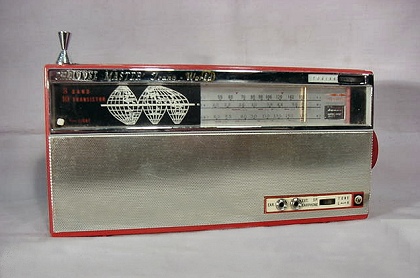A simple crystal set, a 1930s era Zenith console radio and a Zenith Royal 50 pocket transistor radio gave me my first experiences with the world of radio and gave me a start down the path of learning electronics, becoming an amateur radio operator, and selecting a career path to carry me through life.
It all started in the late 1950s when I received a simple
crystal set as a gift from my grandparents. It looked like a
small rocket ship with some wires coming out of the
bottom of it. One
set of wires was an ear piece, and other wire had an alligator clip on
it. I found that the set
worked pretty well when I connected the alligator clip to the finger
stop on a rotary telephone. When I pulled the metal rod out of
the nose of the rocket I could hear a couple of AM broadcast stations,
WEBB, WBAL. I later learned that WEBB was a few miles from where
I lived and WBAL was a high powered broadcast station in Baltimore.
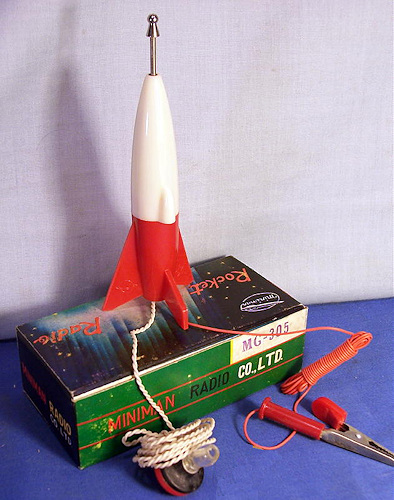 |
|
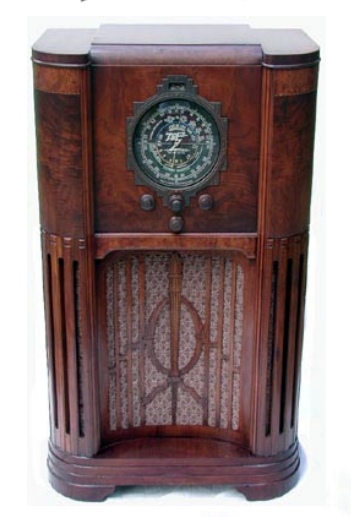 |
|
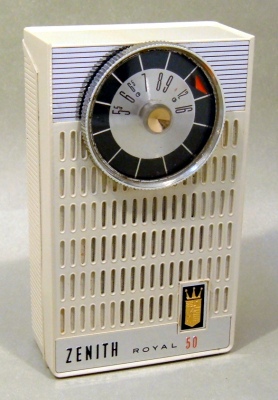 |
| Rocket ship crystal set |
Zenith console radio |
Zenith Royal 50 transistor radio |
Around 1960 I received my first exposure to shortwave radio at age 11 while my mother and grandmother visited my aunt who lived a few miles from us in Essex, Maryland. My mother and grandmother would visit my aunt regularly and during the summer I went along with my younger brother. Aunt Dorothy had a small house in Essex with a partially finished attic. When I got bored with listening to the adults "talk" I would climb the steep narrow staircase leading to the attic and explore. The attic was dark, receiving light from two small windows and a few overhead lights that hung from the ceiling. It had a sloped ceiling with lots of nooks and crannies to explore. In one corner I discovered a large floor model console radio with a large circular dial. It was a Zenith radio like the one in the photo above. With my aunt's permission I listened to the radio to pass the time. On this radio I heard local AM broadcast stations and on other parts of the dial I heard people speaking foreign languages. I passed the time searching for stations and trying to see how many stations I could hear.
In 1962, on my 13th birthday, my grandparents gave me a portable transistor radio, a Zenith Royal 50 shown in the photo above. At that time, transistor radios were beginning to replace tube sets. Pocket size transistor radios were all the rage, much like cell phones today. The quality of your radio was measured by the number of transistors it had. I carried my radio with me everywhere I went since it fit nicely in my shirt pocket. During the evening and night hours I discovered that you could hear distant stations like WBZ in Boston, WGN in Chicago, and WOR in New York City. They all seemed to be a world away, real DX! I started keeping a list of station calls that I heard and in about a years time I logged over a hundred stations on the AM broadcast band. By this time I was in junior high school in the 7th grade. Looking back, this birthday gift was responsibe for cultivating an interest in radio and electronics that would last a lifetime.
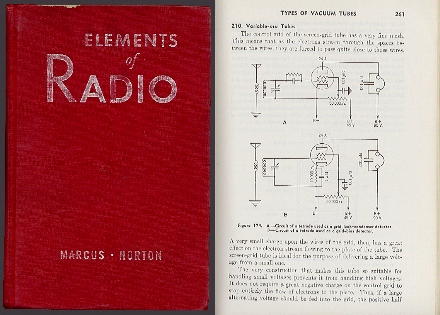 |
|
|
| First electronics
text book |
Later the same year my uncle, an ex-Navy man who attended radio school in Bambridge, Maryland, gave me a book titled "Elements of Radio" which he had used to study electronics in the Navy. I read this book from cover to cover learning about the fundamentals of radio and the inner workings of a radio receiver's RF amplifiers, tuned circuits, detectors, mixers, and audio stages. At that time my uncle was into CB radio. He had started with a Knight kit CB set and later upgraded to a first class station with a Browning Golden Eagle and a set of beams on a short tower in his back yard. At that time he had gotten me into target shooting with bow and arrow. During the summer months I would go to his house and practice my shooting in his back yard where he had a target set up. While at his house I remember watching him talk to CB stations in central and South America.
My interest in electronics and radio continued to grow and in 1963, at age 14, I asked for, and received, a portable shortwave receiver for Christmas. The Channel Master Trans-World radio (photo below) was a real high quality set since it had 14 transistors! By this time I had developed a good understanding of how a radio worked. In fact, I had developed too good of an understanding because it caused me some trouble in school.
In my 8th grade science class we were
given a homework assignment to describe how something worked.
The teacher told us we had to write the paper using our knowledge of
science, without the aid of reference materials. Since I was
an expert on radio, I wrote a detailed description of how a radio
worked, describing each stage of the radio from the antenna, tuner, RF
amplifier, mixer, IF amplifier, detector, and audio
amplifier.
On the day the teacher returned our graded papers, my paper
did not have a grade on it. Instead, it had a note written on
it asking me to see the teacher after class. I did not know
what to make of this! After class the teacher asked me if I
had used a reference book to write my paper. I told him that
I had not used any reference books. He did not
believe me and started asking me questions about radio and
how could a 14 year old kid know so much about radio. After a
long dissertation on how radio worked, and telling him what I had
studied on my own, I finally convinced the teacher that I had not
copied the material from a book. The teacher gave me an
"A"... reluctantly.
|
|
|
|
| Channel Master Trans-World
radio |
In 1964 I began exploring the shortwave bands
with my
portable shortwave radio. One evening I discovered a group
of stations around 4 megacycles (MC) on the dial. This group
could be
found at the same spot on the dial around the same time every
evening. They were on AM and had loud signals on my portable
set. After listening to them for several weeks I strung a
wire out the window and connected it to the external antenna jack on my
radio so I could hear the weaker stations better. I later
learned that they were ham radio
operators. Some of the regulars of the group with the
strongest signals included Bill - W3DUQ, Harry - W3FDY, and others
whose calls I can
no longer remember. Most of the stations were located in
Pennsylvania, New Jersey and New England. They all ran AM
(amplitude modulation) with broadcast quality audio. Their
converations were about technical subjects like techniques for
improving transmitter audio, antennas, and advanced AM modulation
techniques. Super modulation using an "upside down tube" was
a very popular topic. Harry - W3FDY was the senior member of
the group. Both Harry and Bill are silent keys now.
Listening to this nightly activity on the air waves sparked my interest in amateur radio. I did some research at the school library to learn what ham radio was all about and aspired to get my license and get on the air with these guys. I wrote a letter to Bill - W3DUQ telling him about my experiences but never received a reply. In those days you were pretty much on your own. Elmers (amateur radio mentors) were hard to find. I didn't know any amateur radio operators in the neighborhood (after I was licensed I found one two blocks away) so I decided to learn the code on my own - you guessed it - the wrong way, by counting dots and dashes! Using my portable receiver, I tuned the shortwave bands for CW signals. I usually found NSS or WCC to copy. My portable receiver did not have a beat frequency oscillator (BFO), so the signals had to be pretty strong to copy the code. After several weeks of trying to learn morse code in this fashion, I quit in frustration. I continued to listen to hams on-the-air and about a year later, unwilling to give up, I tried again - with the same frustrating result.
In 1964, in the 10th grade, I enrolled in the school's electronics program. It was a three year program where you studied the principles of electronics and applied them in the lab by building an AM radio receiver. In your senior year your project was to build a five tube broadcast band AM radio receiver from scratch. I completed the first year of this program, building a simple crystal receiver and a one tube super regenerative receiver with a tuned input using a tickler coil made from a cardboard tube from a roll of toilet paper. Later that year, my 10th grade guidance counselor advised me that I was college material and recommneded that I switch to mechanical drawing and focus on academic courses in preparation for college. So, on the counselors advice I reluctantly switched to mechanical drawing in the 11th and 12th grade and pursued the academic courses.
Throughout high school, my amateur radio interests were put on the back burner as I pursed other interests... making the high school baseball team, weight lifing, popular music (the British invasion), and writing to penpals in England. I continued to listen to the ham bands and started working to earn spending money. I had been mowing my grandparents lawn each week for my allowance and at age 16 I obtained my first job as a stock boy at a local discount store (GEM). The job lasted only two weeks. The store manager hired me without clearing it with his boss and when the boss found out about it I was let go. The following summer, the summer before my senior year of high school, I acquired a paper route which provided me with spending money until I graduated from high school at which time I had to give up the paper route.
I graduated from Kenwood High School in June 1967. That summer I got a job at Read's Drug Store at the local shopping center which was walking distance from home. I worked there as a cashier full time during the summer months and part time during the evenings while I attended college. I had this job until I finished my first two years of college and joined the Navy.
 Ham Radio
Nostalgia
Ham Radio
Nostalgia
